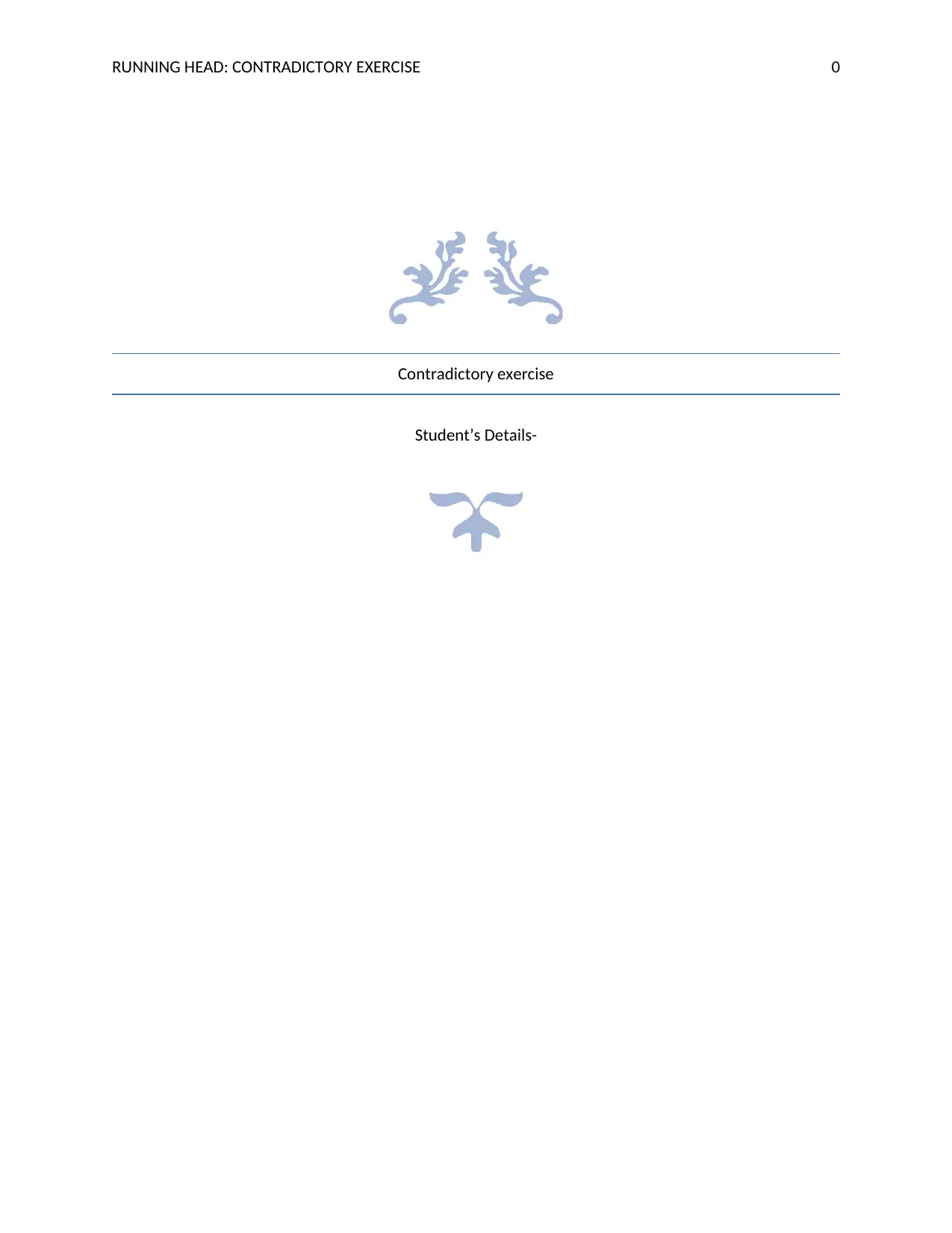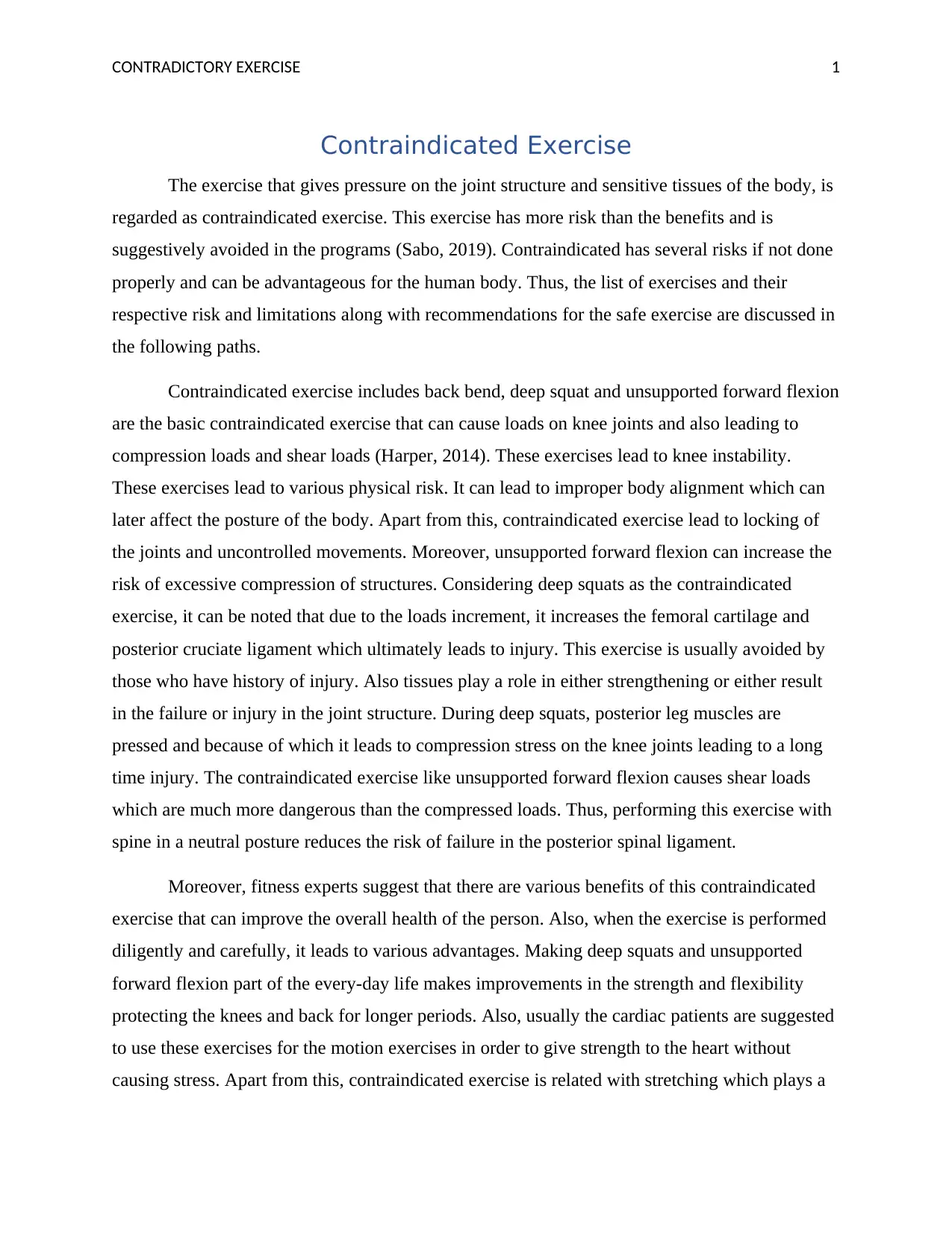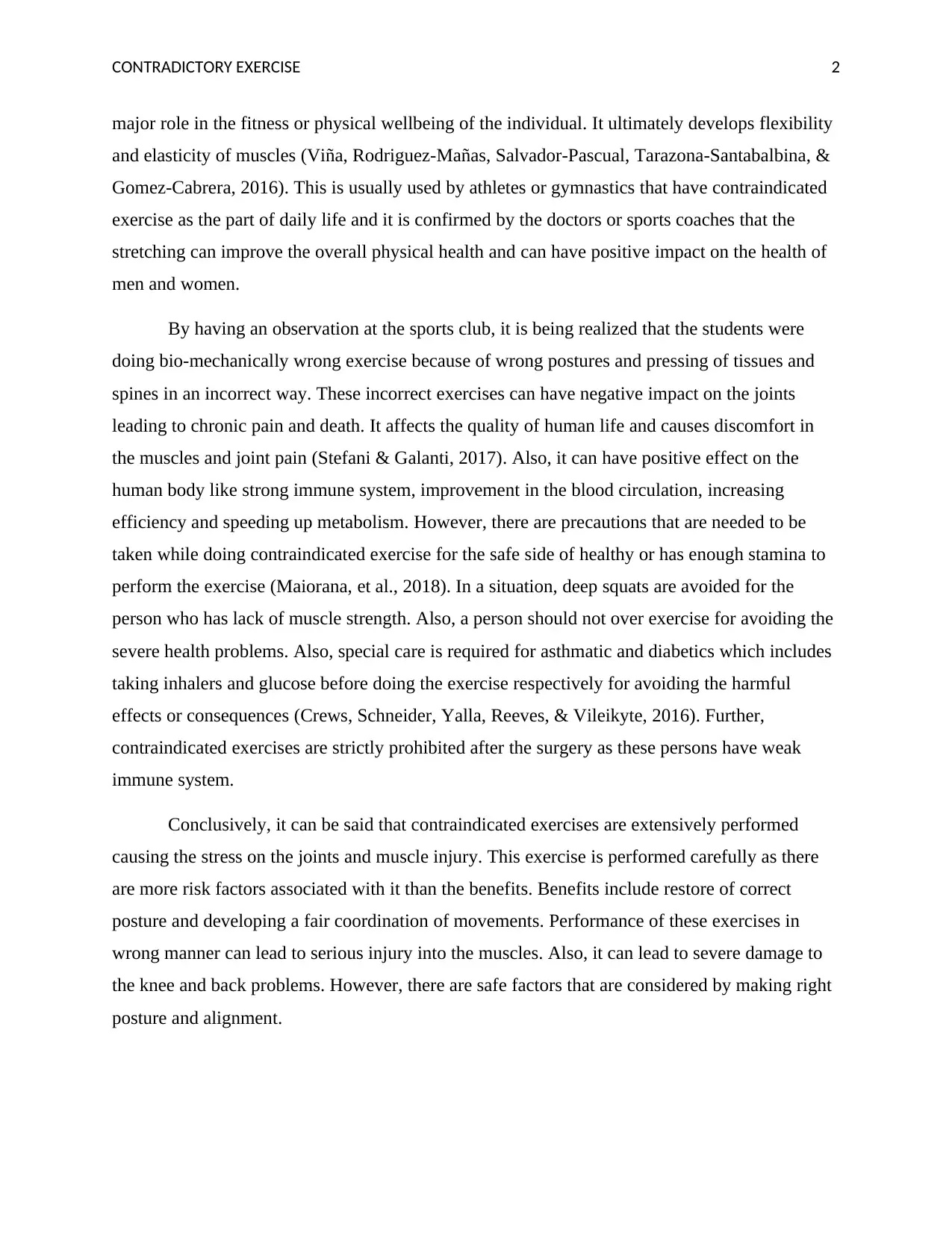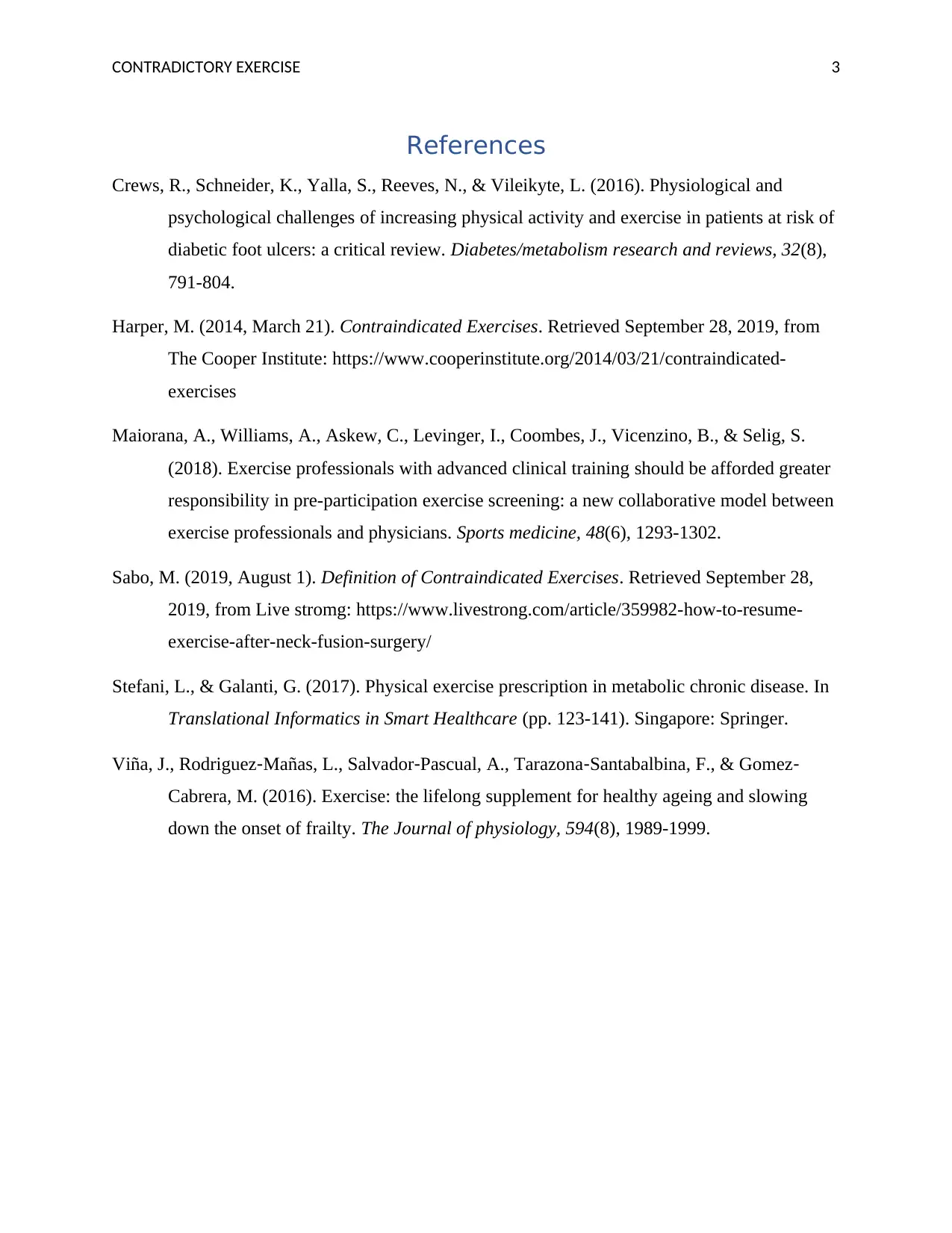Analysis of Contraindicated Exercises: Risks, Benefits, and Safety
VerifiedAdded on 2022/10/11
|4
|1149
|13
Report
AI Summary
This report provides a comprehensive analysis of contraindicated exercises, which are those that pose more risk than benefit to the body. It explores specific exercises like back bends, deep squats, and unsupported forward flexion, detailing the potential risks such as joint pressure, knee instability, and improper body alignment. The report highlights the limitations of these exercises and discusses the physical risks associated with them, including the potential for injuries and chronic pain. It also presents the benefits of these exercises when performed correctly, such as improved strength, flexibility, and cardiovascular health, especially for cardiac patients. Furthermore, the report emphasizes the importance of proper form, precautions for individuals with certain health conditions, and the need for professional guidance to ensure safe and effective exercise practices. The report concludes by summarizing the overall impact of contraindicated exercises on the human body and the need for careful consideration of risks and benefits.

RUNNING HEAD: CONTRADICTORY EXERCISE 0
Contradictory exercise
Student’s Details-
Contradictory exercise
Student’s Details-
Paraphrase This Document
Need a fresh take? Get an instant paraphrase of this document with our AI Paraphraser

CONTRADICTORY EXERCISE 1
Contraindicated Exercise
The exercise that gives pressure on the joint structure and sensitive tissues of the body, is
regarded as contraindicated exercise. This exercise has more risk than the benefits and is
suggestively avoided in the programs (Sabo, 2019). Contraindicated has several risks if not done
properly and can be advantageous for the human body. Thus, the list of exercises and their
respective risk and limitations along with recommendations for the safe exercise are discussed in
the following paths.
Contraindicated exercise includes back bend, deep squat and unsupported forward flexion
are the basic contraindicated exercise that can cause loads on knee joints and also leading to
compression loads and shear loads (Harper, 2014). These exercises lead to knee instability.
These exercises lead to various physical risk. It can lead to improper body alignment which can
later affect the posture of the body. Apart from this, contraindicated exercise lead to locking of
the joints and uncontrolled movements. Moreover, unsupported forward flexion can increase the
risk of excessive compression of structures. Considering deep squats as the contraindicated
exercise, it can be noted that due to the loads increment, it increases the femoral cartilage and
posterior cruciate ligament which ultimately leads to injury. This exercise is usually avoided by
those who have history of injury. Also tissues play a role in either strengthening or either result
in the failure or injury in the joint structure. During deep squats, posterior leg muscles are
pressed and because of which it leads to compression stress on the knee joints leading to a long
time injury. The contraindicated exercise like unsupported forward flexion causes shear loads
which are much more dangerous than the compressed loads. Thus, performing this exercise with
spine in a neutral posture reduces the risk of failure in the posterior spinal ligament.
Moreover, fitness experts suggest that there are various benefits of this contraindicated
exercise that can improve the overall health of the person. Also, when the exercise is performed
diligently and carefully, it leads to various advantages. Making deep squats and unsupported
forward flexion part of the every-day life makes improvements in the strength and flexibility
protecting the knees and back for longer periods. Also, usually the cardiac patients are suggested
to use these exercises for the motion exercises in order to give strength to the heart without
causing stress. Apart from this, contraindicated exercise is related with stretching which plays a
Contraindicated Exercise
The exercise that gives pressure on the joint structure and sensitive tissues of the body, is
regarded as contraindicated exercise. This exercise has more risk than the benefits and is
suggestively avoided in the programs (Sabo, 2019). Contraindicated has several risks if not done
properly and can be advantageous for the human body. Thus, the list of exercises and their
respective risk and limitations along with recommendations for the safe exercise are discussed in
the following paths.
Contraindicated exercise includes back bend, deep squat and unsupported forward flexion
are the basic contraindicated exercise that can cause loads on knee joints and also leading to
compression loads and shear loads (Harper, 2014). These exercises lead to knee instability.
These exercises lead to various physical risk. It can lead to improper body alignment which can
later affect the posture of the body. Apart from this, contraindicated exercise lead to locking of
the joints and uncontrolled movements. Moreover, unsupported forward flexion can increase the
risk of excessive compression of structures. Considering deep squats as the contraindicated
exercise, it can be noted that due to the loads increment, it increases the femoral cartilage and
posterior cruciate ligament which ultimately leads to injury. This exercise is usually avoided by
those who have history of injury. Also tissues play a role in either strengthening or either result
in the failure or injury in the joint structure. During deep squats, posterior leg muscles are
pressed and because of which it leads to compression stress on the knee joints leading to a long
time injury. The contraindicated exercise like unsupported forward flexion causes shear loads
which are much more dangerous than the compressed loads. Thus, performing this exercise with
spine in a neutral posture reduces the risk of failure in the posterior spinal ligament.
Moreover, fitness experts suggest that there are various benefits of this contraindicated
exercise that can improve the overall health of the person. Also, when the exercise is performed
diligently and carefully, it leads to various advantages. Making deep squats and unsupported
forward flexion part of the every-day life makes improvements in the strength and flexibility
protecting the knees and back for longer periods. Also, usually the cardiac patients are suggested
to use these exercises for the motion exercises in order to give strength to the heart without
causing stress. Apart from this, contraindicated exercise is related with stretching which plays a

CONTRADICTORY EXERCISE 2
major role in the fitness or physical wellbeing of the individual. It ultimately develops flexibility
and elasticity of muscles (Viña, Rodriguez‐Mañas, Salvador‐Pascual, Tarazona‐Santabalbina, &
Gomez‐Cabrera, 2016). This is usually used by athletes or gymnastics that have contraindicated
exercise as the part of daily life and it is confirmed by the doctors or sports coaches that the
stretching can improve the overall physical health and can have positive impact on the health of
men and women.
By having an observation at the sports club, it is being realized that the students were
doing bio-mechanically wrong exercise because of wrong postures and pressing of tissues and
spines in an incorrect way. These incorrect exercises can have negative impact on the joints
leading to chronic pain and death. It affects the quality of human life and causes discomfort in
the muscles and joint pain (Stefani & Galanti, 2017). Also, it can have positive effect on the
human body like strong immune system, improvement in the blood circulation, increasing
efficiency and speeding up metabolism. However, there are precautions that are needed to be
taken while doing contraindicated exercise for the safe side of healthy or has enough stamina to
perform the exercise (Maiorana, et al., 2018). In a situation, deep squats are avoided for the
person who has lack of muscle strength. Also, a person should not over exercise for avoiding the
severe health problems. Also, special care is required for asthmatic and diabetics which includes
taking inhalers and glucose before doing the exercise respectively for avoiding the harmful
effects or consequences (Crews, Schneider, Yalla, Reeves, & Vileikyte, 2016). Further,
contraindicated exercises are strictly prohibited after the surgery as these persons have weak
immune system.
Conclusively, it can be said that contraindicated exercises are extensively performed
causing the stress on the joints and muscle injury. This exercise is performed carefully as there
are more risk factors associated with it than the benefits. Benefits include restore of correct
posture and developing a fair coordination of movements. Performance of these exercises in
wrong manner can lead to serious injury into the muscles. Also, it can lead to severe damage to
the knee and back problems. However, there are safe factors that are considered by making right
posture and alignment.
major role in the fitness or physical wellbeing of the individual. It ultimately develops flexibility
and elasticity of muscles (Viña, Rodriguez‐Mañas, Salvador‐Pascual, Tarazona‐Santabalbina, &
Gomez‐Cabrera, 2016). This is usually used by athletes or gymnastics that have contraindicated
exercise as the part of daily life and it is confirmed by the doctors or sports coaches that the
stretching can improve the overall physical health and can have positive impact on the health of
men and women.
By having an observation at the sports club, it is being realized that the students were
doing bio-mechanically wrong exercise because of wrong postures and pressing of tissues and
spines in an incorrect way. These incorrect exercises can have negative impact on the joints
leading to chronic pain and death. It affects the quality of human life and causes discomfort in
the muscles and joint pain (Stefani & Galanti, 2017). Also, it can have positive effect on the
human body like strong immune system, improvement in the blood circulation, increasing
efficiency and speeding up metabolism. However, there are precautions that are needed to be
taken while doing contraindicated exercise for the safe side of healthy or has enough stamina to
perform the exercise (Maiorana, et al., 2018). In a situation, deep squats are avoided for the
person who has lack of muscle strength. Also, a person should not over exercise for avoiding the
severe health problems. Also, special care is required for asthmatic and diabetics which includes
taking inhalers and glucose before doing the exercise respectively for avoiding the harmful
effects or consequences (Crews, Schneider, Yalla, Reeves, & Vileikyte, 2016). Further,
contraindicated exercises are strictly prohibited after the surgery as these persons have weak
immune system.
Conclusively, it can be said that contraindicated exercises are extensively performed
causing the stress on the joints and muscle injury. This exercise is performed carefully as there
are more risk factors associated with it than the benefits. Benefits include restore of correct
posture and developing a fair coordination of movements. Performance of these exercises in
wrong manner can lead to serious injury into the muscles. Also, it can lead to severe damage to
the knee and back problems. However, there are safe factors that are considered by making right
posture and alignment.
⊘ This is a preview!⊘
Do you want full access?
Subscribe today to unlock all pages.

Trusted by 1+ million students worldwide

CONTRADICTORY EXERCISE 3
References
Crews, R., Schneider, K., Yalla, S., Reeves, N., & Vileikyte, L. (2016). Physiological and
psychological challenges of increasing physical activity and exercise in patients at risk of
diabetic foot ulcers: a critical review. Diabetes/metabolism research and reviews, 32(8),
791-804.
Harper, M. (2014, March 21). Contraindicated Exercises. Retrieved September 28, 2019, from
The Cooper Institute: https://www.cooperinstitute.org/2014/03/21/contraindicated-
exercises
Maiorana, A., Williams, A., Askew, C., Levinger, I., Coombes, J., Vicenzino, B., & Selig, S.
(2018). Exercise professionals with advanced clinical training should be afforded greater
responsibility in pre-participation exercise screening: a new collaborative model between
exercise professionals and physicians. Sports medicine, 48(6), 1293-1302.
Sabo, M. (2019, August 1). Definition of Contraindicated Exercises. Retrieved September 28,
2019, from Live stromg: https://www.livestrong.com/article/359982-how-to-resume-
exercise-after-neck-fusion-surgery/
Stefani, L., & Galanti, G. (2017). Physical exercise prescription in metabolic chronic disease. In
Translational Informatics in Smart Healthcare (pp. 123-141). Singapore: Springer.
Viña, J., Rodriguez‐Mañas, L., Salvador‐Pascual, A., Tarazona‐Santabalbina, F., & Gomez‐
Cabrera, M. (2016). Exercise: the lifelong supplement for healthy ageing and slowing
down the onset of frailty. The Journal of physiology, 594(8), 1989-1999.
References
Crews, R., Schneider, K., Yalla, S., Reeves, N., & Vileikyte, L. (2016). Physiological and
psychological challenges of increasing physical activity and exercise in patients at risk of
diabetic foot ulcers: a critical review. Diabetes/metabolism research and reviews, 32(8),
791-804.
Harper, M. (2014, March 21). Contraindicated Exercises. Retrieved September 28, 2019, from
The Cooper Institute: https://www.cooperinstitute.org/2014/03/21/contraindicated-
exercises
Maiorana, A., Williams, A., Askew, C., Levinger, I., Coombes, J., Vicenzino, B., & Selig, S.
(2018). Exercise professionals with advanced clinical training should be afforded greater
responsibility in pre-participation exercise screening: a new collaborative model between
exercise professionals and physicians. Sports medicine, 48(6), 1293-1302.
Sabo, M. (2019, August 1). Definition of Contraindicated Exercises. Retrieved September 28,
2019, from Live stromg: https://www.livestrong.com/article/359982-how-to-resume-
exercise-after-neck-fusion-surgery/
Stefani, L., & Galanti, G. (2017). Physical exercise prescription in metabolic chronic disease. In
Translational Informatics in Smart Healthcare (pp. 123-141). Singapore: Springer.
Viña, J., Rodriguez‐Mañas, L., Salvador‐Pascual, A., Tarazona‐Santabalbina, F., & Gomez‐
Cabrera, M. (2016). Exercise: the lifelong supplement for healthy ageing and slowing
down the onset of frailty. The Journal of physiology, 594(8), 1989-1999.
1 out of 4
Your All-in-One AI-Powered Toolkit for Academic Success.
+13062052269
info@desklib.com
Available 24*7 on WhatsApp / Email
![[object Object]](/_next/static/media/star-bottom.7253800d.svg)
Unlock your academic potential
Copyright © 2020–2025 A2Z Services. All Rights Reserved. Developed and managed by ZUCOL.


